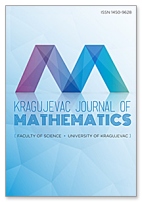Double Total Domination Number on Some Chemical Nanotubes.
 Download PDF
Download PDF
Authors: A. KLOBUčAR BARIšIć AND A. KLOBUčAR
DOI: 10.46793/KgJMat2603.415B
Abstract:
Suppose G is a graph with the vertex set V (G). A set D ⊆ V (G) is a total k-dominating set if every vertex v ∈ V (G) has at least k neighbours in D. The total k-domination number γkt(G) is the size of the smallest total k-dominating set. When k = 2 the total 2-dominating set is referred to as a double total dominating set. In this work we compute the exact values for double total domination number on H-phenylenic nanotubes HPH(m,n), m,n ≥ 2 and H-naphtalenic nanotubes HN(m,n), n = 2k, m,n ≥ 2. As all vertices have a degree 2 or 3, there is no total k-domination for k ≥ 3 for H-phenylenic and H-naphtalenic nanotubes, and the double total domination is the maximum possible.
Keywords:
Total domination, double total domination, hexagonal systems, molecular graph, H-phenylenic nanotube, H-naphtalenic nanotube.
References:
[1] A. Bahrami and J. Yazdani, PI Index of H-phenylenic nanotubes and nanotori, Dig. J. Nanomater. Biostruct. 3(4) (2008), 265–276.
[2] S. Bermudo, R. A. Higuiata and J. Rada, k-Domination and total k-domination in catacondensed hexagonal systems, Math Biosci Eng. 19(7) (2022), 7138–7155. https://doi.org/10.3934/mbe.2022337
[3] S. Bermudo, J. C. Hernández-Gómez and J. M. Sigarreta, On the total k-domination in graphs, Discuss. Math. Graph Theory 38 (2018), 301–317. https://doi.org/10.7151/dmgt.2016
[4] E. J. Cockayne, R. M Dawes and S. T. Hedetniemi, Total domination in graphs, Networks 10 (1980), 211–219. https://doi.org/10.1002/net.3230100304
[5] H. Fernau, J. A. Rodríguez-Velázquez and J. M. Sigarreta, Global powerful r-alliances and total k-domination in graphs, Util. Math. 98 (2015), 127–147.
[6] Y. Gao Y, E. Zhu, Z. Shao, I. Gutman and A. Klobučar, Total domination and open packing in some chemical graphs, J. Math. Chem. 56 (2018), 1481–1493. https://doi.org/10.1007/s10910-018-0877-6
[7] M. A. Henning and A. P. Kazemi, k-Tuple total domination in graphs, Discrete Appl. Math. 158 (2010), 1006–1011. https://doi.org/10.1016/j.dam.2010.01.009
[8] M. A. Henning, D. Rautenbach and P. M. Schäfer, Open packing, total domination and P3-Radon number, Discrete Math. 313 (2009), 992–998, https://doi.org/10.1016/j.disc.2013.01.022
[9] L. Hutchinson, V. Kamat, C. E. Larson, S. Metha, D. Muncy D and N. Van Cleemput, Automated conjecturing VI : domination number of benzenoids, Match-Commun. Math. Comput. Chem. 80 (2018), 821–834.
[10] A. Klobučar and A. Klobučar, Total and double total domination on hexagonal grid, Mathematics MDPI 11(7) (2019), 1110–1121. https://doi.org/10.3390/math7111110
[11] A. Klobučar, Total domination numbers of Cartesian products, Math. Commun. 9 (2004), 35–44.
[12] A. Klobučar and A. Klobučar, Double total domination number in certain chemical graphs, AIMS Mathematics 7(11) (2022), 19629–19640. https://doi.org/10.3934/math.20221076
[13] S. Majstorović, T. Došlić and A. Klobučar, k-Domination on hexagonal cactus chains, Kragujev. J. Math. 36 (2012), 335–347.
[14] S. Majstorović and A. Klobučar, Upper bound for total domination number on linear and double hexagonal chains, Int. J. Chem. Model. 3(1–2) (2009), 139–145.
[15] D. A. Mojdeh, M. Habibi and L. Badakhshian, Total and connected domination in chemical graphs, Ital. J. Pure Appl. Math. 39 (2018), 393–401.
[16] J. Quadras, A. S. M. Mahizl, I. Rajasingh and R. S. Rajan, Domination in certain chemical graphs, J. Math. Chem. 53 (2015), 207–219. https://doi.org/10.1007/s10910-014-0422-1
[17] D. Vukičević and A. Klobučar, k-Dominating sets on linear benzenoids and on the infinite hexagonal grid, Croat. Chem. Acta. 80 (2007), 187–191.
[18] J. Yazdani and A. Bahrami, Topological descriptors of H-naphtalenic nanotubes, Dig. J. Nanomater. Biostruct. 4(1) (2009), 209–212.
